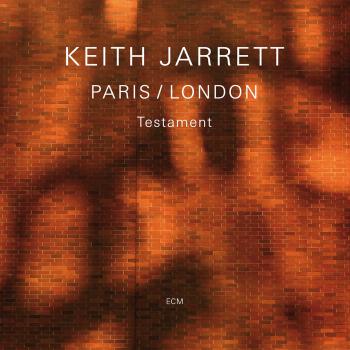
Eyes of the Heart Keith Jarrett
Album info
Album-Release:
2015
HRA-Release:
04.05.2015
Album including Album cover Booklet (PDF)
I`m sorry!
Dear HIGHRESAUDIO Visitor,
due to territorial constraints and also different releases dates in each country you currently can`t purchase this album. We are updating our release dates twice a week. So, please feel free to check from time-to-time, if the album is available for your country.
We suggest, that you bookmark the album and use our Short List function.
Thank you for your understanding and patience.
Yours sincerely, HIGHRESAUDIO
- 1 Eyes of the Heart, Pt. I 17:14
- 2 Eyes of the Heart, Pt. II 15:43
- 3 Encore 18:04
Info for Eyes of the Heart
Keith Jarrett's two primary '70s performing ensembles were based on two different continents (North America and Europe), and, for the most part, recorded for two different labels (Impulse and ECM). This 1976 recording of his American quartet was originally released in 1979, after they'd disbanded. Recorded live in concert in Austria, they're at their most organic here.
With Eyes Of The Heart, musician’s musician Keith Jarrett landed one of his last American Quartet flights. This live performance, recorded just one month after The Survivors’ Suite, is a journey of different stripes. Jarrett whoops with delight as he opens Part One amid a congregation of drums. The kalimba-like bass of Charlie Haden hops from one foot to another as Jarrett looses a soprano sax into the prevailing winds. Only later does the expected piano shine through his fingertips. Writ somehow large with modest articulations, his right hand brings gradual insistence until the melody and the moment become one, each frame sped into a moving image. Part Two begins with more lovely pianism, this time with grittier chording and the added sheen of Paul Motian’s kit work. An insistent vamp unravels Dewey Redman’s dazzling tenor, and cushions the applause that follow. The tripartite encore is an uplifting, jaunty exposition. Some fantastic drumming and elegant exchanges between soprano and tenor dim themselves silent before the altar of Jarrett’s concluding piano solo.
Just when I think I’ve encountered the extent of Jarrett’s immeasurable talents, he surprises me with an album like this. It’s always a pleasure to hear his peripheral instrumental work, for his talents at the keyboard transfer effortlessly to reed by way of our grateful hearts. Perhaps the title is more than just a metaphor.
Keith Jarrett, piano, soprano saxophone, percussion
Dewey Redman, tenor saxophone, percussion
Charlie Haden, bass
Paul Motian, drums, percussion
Recorded live May 1976 at Theater am Kornmarkt, Bregenz, Austria
Engineered by Martin Wieland at at Tonstudio Bauer, Ludwigsburg, Germany
Produced by Manfred Eicher
Digitally remastered
Keith Jarrett
At the end of 2008, Keith Jarrett added two concerts to his schedule at short notice – one at Paris’s Salle Pleyel (November 26), one at London’s Royal Festival Hall (December 1) . The music on “Testament” is from these concerts. Their range is compendious, Jarrett’s improvisational imagination continually uncovering new forms, in a music stirred by powerful emotions. In his liner notes, the pianist is forthright about the personal circumstances promoting a need to lose himself in the work once more.
He also reminds the reader/listener that “it is not natural to sit at a piano, bring no material, clear your mind completely of musical ideas and play something that is of lasting value and brand new.” This, however, has been the history and substance of the solo concerts since Jarrett initiated them, almost forty years ago . Over time their connection to ‘jazz’ has often become tenuous, yet Jarrett’s solo concerts, with the foregrounding of melody and the continual building, and relinquishing, of structure, are also removed from “free improvisation” as a genre. Jarrett’s solo work is effectively its own idiom, and has been subject to periodic revisions by the pianist. “In the early part of this decade, I tried to bring the format back: starting from nothing and building a universe.”
Since the “Radiance” album and the “Tokyo Solo” DVD of 2002 Jarrett has been adjusting the flow of the work, more often working with shorter blocks of material. “I continued to find a wealth of music inside this open format, stopping whenever the music told me to.” This approach distinguished “The Carnegie Hall Concert” (2006), and it is most effectively deployed in “Testament” , where the strongly-contrasting elements of the sections of the Paris concert in particular have the logic of a spontaneously-composed suite. The nerves-bared London performance (the first UK solo show in 18 years) is different again: “The concert went on and, though the beginning was a dark, searching, multi-tonal melodic triumph, by the end it somehow became a throbbing, never-to-be-repeated pulsing rock band of a concert (unless it was a church service, in which case, Hallelujah!).”
In the end, the improviser does what must be done. As Keith Jarrett said, a long time ago, “If you’re a rock climber, once you’re halfway up the face of the cliff, you have to keep moving, you have to keep going somewhere. And that’s what I do, I find a way.”
These days, however, Jarrett is rationing the number of ascents: there have been less than thirty solo concerts in the last decade, making “Testament” a special event indeed. Two further solo performances are scheduled for 2009 – at the Palais des Beaux Arts in Brussels on October 9, and at Berlin’s Philharmonie on October 12.
Booklet for Eyes of the Heart
























